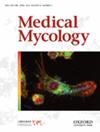Segmentation of hyphae and yeast in fungi-infected tissue slice images and its application in analyzing anti-fungal blue light therapy
IF 2.7
3区 医学
Q3 INFECTIOUS DISEASES
引用次数: 0
Abstract
Candida albicans (C. albicans) is a pathogenic fungus that undergoes morphological transitions between hyphal and yeast, adapting to diverse environmental stimuli and exhibiting distinct virulence. Existing researches on anti-fungal blue light (ABL) therapy have either focused solely on hyphae or neglected to differentiate between morphologies, obscuring potential differential effects. To address this gap, we established a novel dataset of 150 C. albicans-infected mouse skin tissue slice images with meticulously annotated hyphae and yeast. Eleven representative convolutional neural networks were trained and evaluated on this dataset using seven metrics to identify the optimal model for segmenting hyphae and yeast in original high pixel size images. Leveraging the segmentation results, we analyzed the differential impact of blue light on the invasion depth and density of both morphologies within the skin tissue. Comparison results demonstrated that U-Net-BN emerged as superior segmentation accuracy compared to other models, achieving the best overall performance. While both hyphae and yeast exhibited significant reductions in invasion depth and density at the highest ABL dose (180 J/cm2), only yeast was significantly inhibited at the lower dose (135 J/cm2). This novel finding emphasizes the importance of developing more effective treatment strategies for both morphologies.真菌感染组织切片图像中菌丝和酵母的分割及其在分析抗真菌蓝光疗法中的应用
白色念珠菌(C. albicans)是一种致病真菌,可在菌丝和酵母之间进行形态转换,适应不同的环境刺激并表现出不同的毒力。现有的抗真菌蓝光(ABL)疗法研究要么只关注菌丝,要么忽视了形态之间的差异,从而掩盖了潜在的不同效应。为了弥补这一不足,我们建立了一个新的数据集,其中包含 150 张白僵菌感染的小鼠皮肤组织切片图像,并对菌丝和酵母进行了细致的注释。在该数据集上使用七种指标对 11 个代表性卷积神经网络进行了训练和评估,以确定在原始高像素尺寸图像中分割菌丝和酵母的最佳模型。利用分割结果,我们分析了蓝光对皮肤组织内两种形态的侵入深度和密度的不同影响。比较结果表明,与其他模型相比,U-Net-BN 的分割精度更高,总体性能最佳。虽然在最高 ABL 剂量(180 J/cm2)下,菌丝和酵母菌的侵袭深度和密度都有显著降低,但在较低剂量(135 J/cm2)下,只有酵母菌受到显著抑制。这项新发现强调了针对这两种形态开发更有效治疗策略的重要性。
本文章由计算机程序翻译,如有差异,请以英文原文为准。
求助全文
约1分钟内获得全文
求助全文
来源期刊

Medical mycology
医学-兽医学
CiteScore
5.70
自引率
3.40%
发文量
632
审稿时长
12 months
期刊介绍:
Medical Mycology is a peer-reviewed international journal that focuses on original and innovative basic and applied studies, as well as learned reviews on all aspects of medical, veterinary and environmental mycology as related to disease. The objective is to present the highest quality scientific reports from throughout the world on divergent topics. These topics include the phylogeny of fungal pathogens, epidemiology and public health mycology themes, new approaches in the diagnosis and treatment of mycoses including clinical trials and guidelines, pharmacology and antifungal susceptibilities, changes in taxonomy, description of new or unusual fungi associated with human or animal disease, immunology of fungal infections, vaccinology for prevention of fungal infections, pathogenesis and virulence, and the molecular biology of pathogenic fungi in vitro and in vivo, including genomics, transcriptomics, metabolomics, and proteomics. Case reports are no longer accepted. In addition, studies of natural products showing inhibitory activity against pathogenic fungi are not accepted without chemical characterization and identification of the compounds responsible for the inhibitory activity.
 求助内容:
求助内容: 应助结果提醒方式:
应助结果提醒方式:


